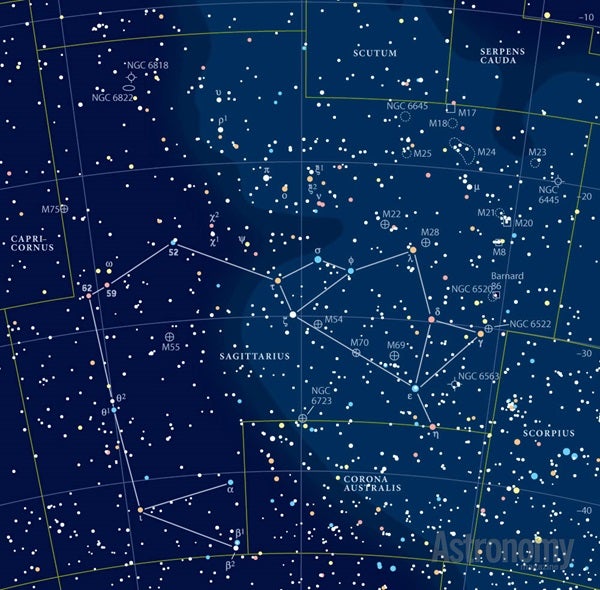Targets for August 20–27, 2015
Small telescope:
Globular cluster M28
Small telescope:
Open cluster M25
Large telescope:
Planetary nebula NGC 6781
This week’s first small-telescope target is globular cluster M28 in Sagittarius. French comet-hunter Charles Messier discovered and cataloged it July 27, 1764.
This object lies 1° northwest of magnitude 2.8 Lambda (λ) Sagittarii. It shines at magnitude 6.8 and measures 11.2′ across. That means it covers an area 13 percent as large as that covered by the Full Moon.
This object has plenty of brightness and a great background star field to impress most viewers using a 4-inch telescope. But its stars pack together closely, so you might want to point a bigger scope at it sometime.
Through an 8-inch telescope at 150x, you’ll resolve several dozen stars in M28’s wide halo. And if you can step up to a 14-inch instrument, your star count will climb past 150. Viewing the core at 250x or above gives a three-dimensional effect. A relatively bright chain of stars extends to the north. Another fainter one heads to the north-northwest.
Two Messier-sippi
This week’s second small-scope object is another from Messier’s catalog. This time it’s open cluster M25, also in Sagittarius. To find it, look 4.4° east-northeast of magnitude 3.8 Mu (μ) Sagittarii.
At a striking magnitude 4.6, it’s visible to the naked eye from a dark site, but not easily because of the richness of the Milky Way background. The cluster’s brightness also spreads out over a fairly large area. M25 is 32′ in diameter, so it covers 6 percent more area than the Full Moon.
A 4-inch telescope at a magnification of 150 reveals 40 member stars. Two chains of stars divided by a starless gap stretch east to west near the center. Many of M25’s stars exceed 11th magnitude, making this a nice sight through small telescopes. Yellow magnitude 6.8 SAO 161557 sits at the northwest edge.
Aquila’s standout object
This week’s large-telescope target is planetary nebula NGC 6781 in Aquila. Although this constellation ranks 22nd in size among the 88 that cover the sky, it contains no Messier objects or emission nebulae and few bright star clusters. Still, you’ll want to point your telescope 3.8° north-northwest of magnitude 3.4 Delta (δ) Aquilae to observe NGC 6781.
This planetary nebula is an almost perfect bubble of gas cast off by a formerly Sun-like star that died. The bubble measures 2 light-years across and continues to expand. Energetic photons from nearby bright stars decompose the gas bubble. A similar process occurs within the Eagle Nebula (M16).
Through a 6-inch telescope at a magnification of 100, magnitude 11.4 NGC 6781 stands out well against a rich, star-filled background. The disk appears soft, irregular, and oval-shaped with a slightly darker center. If the seeing at your observing site is good, look for small, dark blotches over NGC 6781’s face. This isn’t a small object — it measures 109″ across.
If you’re able to observe NGC 6781 through a 16-inch scope, you’ll see lots of structure in the nebula’s thick ring. This feature’s southern rim appears brightest. The northern edge is broken and gradually fades into the background.
To see the ring best, use a nebula or an OIII filter. Through a 16-inch or larger telescope, you might detect the central star, a bluish white dwarf, which glows weakly at magnitude 16.2.
Expand your observing at Astronomy.com
StarDome
Check out Astronomy.com’s interactive StarDome to see an accurate map of your sky. This tool will help you locate this week’s targets.
The Sky this Week
Get a daily digest of celestial events coming soon to a sky near you.
Observing Talk
After you listen to the podcast and try to find the objects, be sure to share your observing experience with us by leaving a comment at the blog or in the Reader Forums.











